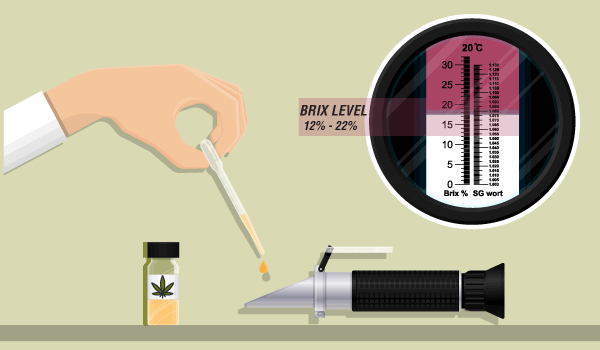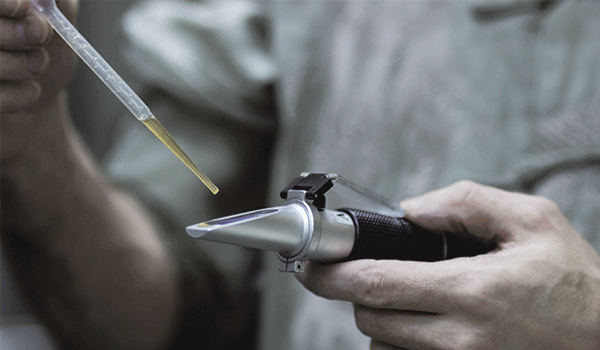The Role of Sugar In Cannabis Cultivation
Published :
Aug 6, 2019
Categories :
Cannabis cultivation

Sugar carbohydrates are an essential source of energy for cannabis plants. Read on to learn more about the role of sugar in cannabis, as well as how to boost sugar levels in developing plants.
Most cannabis smokers may be surprised to find out that sugar plays a significant role in the growth and development of the cannabis plant. Indeed, sugar is a crucial ingredient in the sticky green cannabis buds we all love so much. Through the process of photosynthesis, plants convert light energy into sugar carbohydrates, which act as plant fuel. These sugars function as a vital source of energy throughout the life of cannabis plants. Keep reading to find out how to measure and increase the sugar carbohydrate concentration of your marijuana plants.
SUGAR AS ENERGY
Some sugar carbohydrates function as a primary energy source for cannabis plants, feeding the buds and leaves throughout their lives. Meanwhile, other sugars function as cellulose for plants, contributing to their structure.
Cannabis plants produce sugar carbohydrates as a result of photosynthesis. Photosynthesis is the process by which plants convert light, carbon dioxide (CO₂), and water (H₂O) into oxygen (O₂) for the environment around them, and sugar energy for themselves. A chemical called chlorophyll is used to convert the light energy the plant absorbs into useable food energy. At night, or during an otherwise dark period, the plant will switch from energy production to protein production and oxygen processing.
Sugar is primarily produced in maturing leaves, as they typically take in the most sunlight. Fully-grown, matured leaves are a cannabis plant’s main source of sugar production. As such, some growers prefer to trim smaller leaves and stems that may distract a plant’s energy from being concentrated in these areas.
Sugar carbohydrates that are consumed for energy are known as “non-structural carbohydrates”. Some of the sugars created during photosynthesis are immediately consumed for energy. Meanwhile, others are distributed throughout the plant where they are stored in reserve for later energy needs.
Sugar carbohydrates are especially important during a plant’s flowering period when energy is needed the most. A plant will require the most carbohydrates around week 4 of its bloom stage when it is most focussed on bud production. Well-fed cannabis plants with well-stocked sugar reserves will develop thick, potent, and resinous buds. Maximising sugar production and sugar reserves is essential to maximising terpene and resin production in buds.
.png)
SUGAR AS STRUCTURE
Sugars also contribute to the cellular structure of plants. In the case of cannabis, sugars contribute 80% of the plant’s structure. These kinds of sugar carbohydrates are known as “structural carbohydrates". They function as vital building blocks, helping to develop cell walls throughout the plant.
THE IMPORTANCE OF SUGAR DISTRIBUTION
In addition to sugar production, cannabis plants also need to effectively distribute the sugars. Before storing sugar reserves, marijuana plants first transport carbohydrates to the locations where they will be needed in the future.
The distribution method that marijuana plants use to mobilise carbohydrates is called “sink strength”. Sugars flow downwards throughout the plant and its organs, almost as if they were sinking.
Certain parts of the plant are more demanding and exert a much stronger pull on carbohydrate resources. As such, sugars do not always flow or sink at the same rate throughout the entire plant. Experts believe that a plant’s main bud sites can have a pull/sink strength nearly 3 times stronger than that of younger leaves.
There is very little waste when it comes to the distribution of sugars. Mature leaves and main colas will always demand and acquire the most sugar resources. This is because female cannabis plants will always prioritise the production of buds over leaves.
HOW ARE SUGAR LEVELS MEASURED IN CANNABIS PLANTS?
The amount of sugar carbohydrates present in a plant is determined through the measurement of its Brix levels. Brix levels measure the angle at which light moves through sap. When it comes to cannabis plants, Brix levels effectively tell us the amount of sugar they contain. They do this by measuring the amount of solid matter present in the plant’s juices. The higher the Brix levels found in a plant, the healthier and better-off it is.
Brix levels can be measured using a small handheld refractometer tool. Ideally, you should use one specifically designed for measuring Brix/sugar levels between 0–32%. The ideal refractometer tool should also automatically account for temperature.
The first step to measuring the Brix level of a marijuana plant is calibrating the refractometer with distilled water. A reading of 0% should confirm that the refractometer is working correctly and is ready to test cannabis.
Cannabis plants are tested by measuring their juices. A small leaf should be picked from the plant and crushed to produce juice. This juice can then be tested using the refractometer. In order to get the most accurate reading possible, try to make sure that the juice is pure, and not contaminated with plant matter.
The general consensus among growers is that the optimal Brix level of a cannabis plant should be approximately 22%. However, only a minimum baseline of 12% is considered necessary in order to raise a healthy plant. If you find that your plant’s levels are below these, you may want to look at ways to increase their sugar carbohydrate concentration.
In addition to their Brix levels, marijuana plants can also give you an indication of their energy reserves through their appearance. Plants that contain high sugar and mineral content tend to develop a healthy, shiny, waxy veneer.

INCREASING THE SUGAR LEVELS OF YOUR CANNABIS PLANTS
One way to boost the sugar production of your cannabis plants is to increase the amount of CO₂ in their growing environment. In combination with light and water, added carbon dioxide will naturally increase a plant’s sugar production capabilities. While this method may work, it can be arduous and impractical. Thankfully, there are easier ways to increase a plant’s sugar production through the use of products that enhance the absorption of nutrients, or increase the production of chlorophyll.
IMPROVING SUGAR PRODUCTION WITH NUTRIENTS AND ADDITIVES
One way to increase a marijuana plant’s sugar content is to raise its potassium-to-nitrate ratio. Since excessive nitrates burn carbohydrates and waste energy, increasing potassium levels will lead to an increase in the plant’s Brix levels. Additionally, plants with high nitrate levels tend to develop weaker cellular structures, making them more susceptible to pests and disease. As such, monitoring nitrate intake and adjusting potassium intake accordingly is crucial to maintaining energy levels and overall plant health.
Some growers have also been successful in raising their Brix levels through the use of seaweed extracts. Seaweed extracts increase the bioavailability of micronutrients, and are packed with natural growth hormones that stimulate a plant’s cell division. When applied to the root area of a plant, seaweed extracts trigger the development of heavier and more pronounced roots. Larger and thicker roots will allow the plant to absorb more water and nutrients, thus increasing its carbohydrate production capabilities.
Another way to increase the Brix levels of a marijuana plant is through the use of amino acid blends. When applied to plants, amino acid blends improve the uptake of nutrients, especially calcium. Calcium works to strengthen the vascular systems and stems of plants, making water and nutrient transportation more efficient. With water and nutrients being absorbed more effectively and transported more freely, Brix levels will naturally rise over time.

IMPROVING SUGAR PRODUCTION BY TRIMMING LIVE PLANTS
One of the easiest and most common ways to boost a growing cannabis plant’s sugar production is to trim its leaves. A female marijuana plant’s main focus is the development of thick, resinous buds (as long as she has not been fertilised by a male). As such, a plant will naturally direct its energy resources toward bud production sites. Trimming, otherwise known as defoliation or pruning, is the process of removing unnecessary or unwanted plant growth, typically with a cutting tool such as shears.
Trimming to increase sugar production does not require the removal of large fan leaves, only young foliage. These small leaves exist only to consume energy. A plant has limited energy resources, and removing small and unnecessary foliage will allow that energy to be put to better use. In the case of cannabis, that energy will be directed toward the production of buds, potentially increasing your final yield as a result.
It is especially important not to remove or damage a plant’s topmost fan leaves. Since these leaves have the most exposure to sunlight, they inevitably produce most of the plant’s sugar resources. Most trimming should be restricted to bottom-level foliage. Since these areas do not receive much exposure to light, they do not produce much energy, and consequently do not contribute much to the development of cannabis buds. Keeping a close eye on your plants as they grow can help you to get the jump on new growth.






































